I’m a pretty cultured person…
I might not attend any ballets, operas, or art shows, but my little homestead kitchen is packed full of cultured butter, cultured yogurt, and cultured buttermilk. That counts, right? 😉
Learning how to make buttermilk is one of the easiest things to do if you are just starting out in the world of home dairy. And real homemade buttermilk is out-of-this world.
One word of warning– once you make your first batch of homemade buttermilk, you’ll likely never be satisfied with the store-bought versions again…
If you’re smack-dab in the middle of a baking project and stumbled on this post looking for a quick buttermilk substitute, you won’t want to wait for your milk to culture. Instead, simply add 1 tablespoon of lemon juice or vinegar to 1 cup of milk. Stir. Once you see tiny curdles forming in the milk, you can use it. And then come back later to make real culture buttermilk. 😉
How to Make Buttermilk
First, let’s set the record straight– there are actually two different kinds of buttermilk:
- Cultured buttermilk– this is the kind we’re making today.
- Old-Fashioned or traditional buttermilk — this is the kind resulting from making butter. (Here’s how to make your own butter. )
Although you can use both types of buttermilk to make those buttermilk biscuits or pancakes, cultured buttermilk is my favorite because it is thick and creamy and has the most delightful tangy smell.
Cultured buttermilk is also an excellent probiotic-base for your dips and salad dressings.
How to Make Buttermilk (Cultured Version)
(this post contains affiliate links)
- 4 cups whole milk (see note below)
- ONE of the following:
- 1 packet of direct-set buttermilk starter culture (where to buy buttermilk culture)
- OR 1/8th teaspoon mesophilic starter culture (where to buy mesophilic culture)
- OR 1 cup cultured buttermilk from the store*
*If using 1 cup of cultured buttermilk as your starter, reduce the amount of whole milk to 3 cups.
Gently stir the starter culture into the milk (I use a mason jar) and cover it with a towel and rubber band. Avoid capping it tightly with a lid, as the culture needs room to breathe.
Allow the milk to culture at room temperature for 12-24 hours. When it is complete, the buttermilk will be thick and have a delicious tangy smell.
Store your finished buttermilk in the fridge (it usually lasts at least several weeks for me).
Homemade Buttermilk Notes:
- I always use my raw milk when making homemade buttermilk, although pasteurized milk will work too. Just avoid ultra-pasteurized milk (UHT) as it will produce inconsistent results.
- Although it’s handy to buy the powdered buttermilk culture and store it in your fridge, I prefer using existing cultured buttermilk to make my fresh batches. I think it has a better tang to it.
- Use your tangy homemade buttermilk to create probiotic dips, dressings, and smoothies. Or, use it in your favorite baked goods–like my favorite flaky Buttermilk Biscuits.
- If your buttermilk doesn’t thicken within 12-24 hours, it may be due to one of the following factors:
- The starter culture was dead or inactive
- It needs to culture a bit longer
- Your kitchen is abnormally cold
- If you accidentally culture your buttermilk too long, that’s OK. It’ll just be a little thicker (more like the consistency of yogurt), but it’s still totally usable.
How to Make Sour Cream
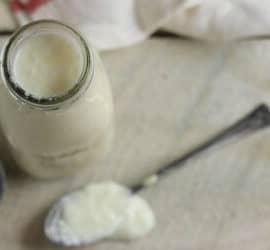
- Yield: 1 quart 1x
- Category: Home Dairy
Ingredients
- 4 cups whole milk (see note below)
- ONE of the following:
- 1 packet of direct-set buttermilk starter culture (like this)
- OR 1/8th teaspoon mesophilic starter culture (like this)
- OR 1 cup cultured buttermilk from the store*
- *If using 1 cup of cultured buttermilk as your starter, reduce the amount of whole milk to 3 cups.
Instructions
- Gently stir the starter culture into the milk (I use a mason jar) and cover it with a towel and rubber band. Avoid capping it tightly with a lid, as the culture needs room to breathe.
- Allow the milk to culture at room temperature for 12-24 hours. When it is complete, the buttermilk will be thick and have a delicious tangy smell.
- Store your finished buttermilk in the fridge (it usually lasts at least several weeks for me)
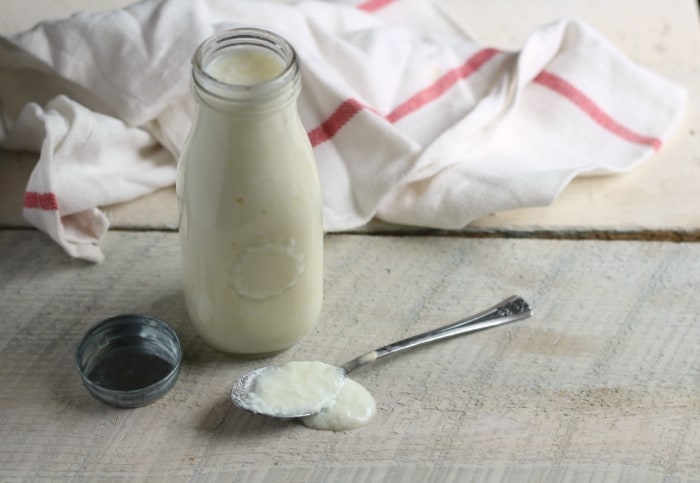
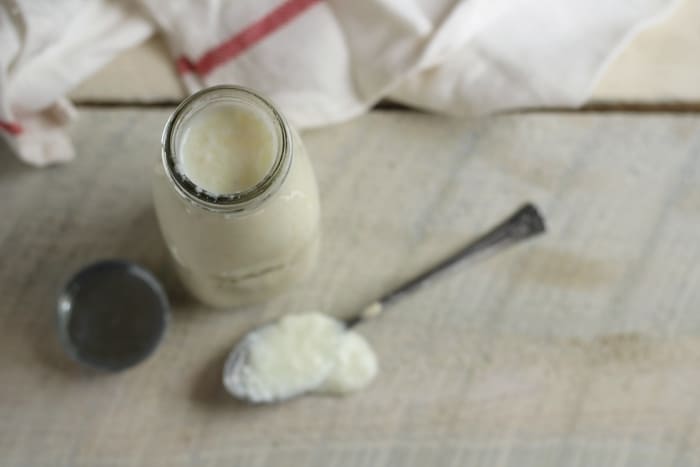
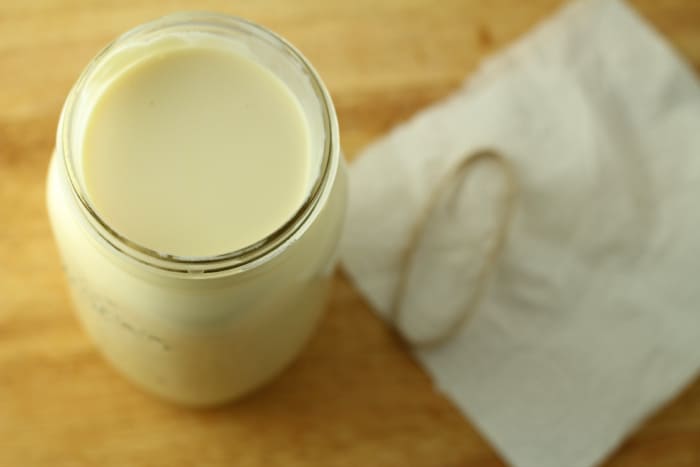
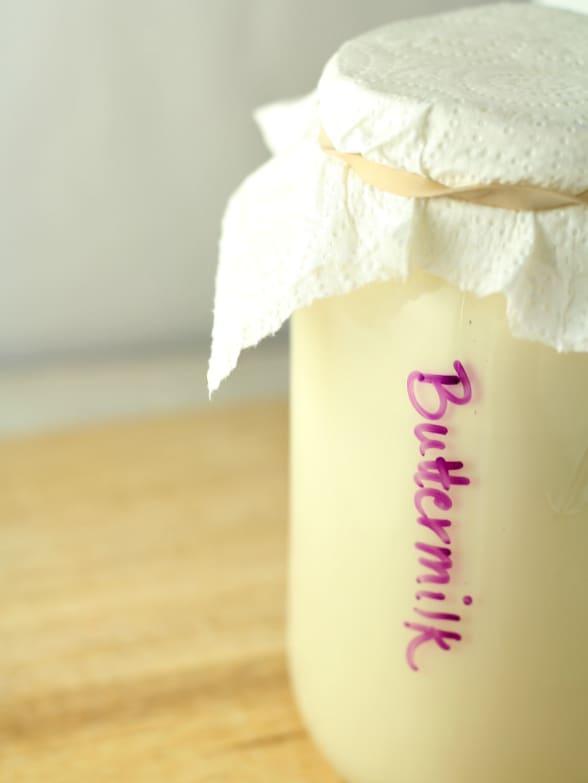
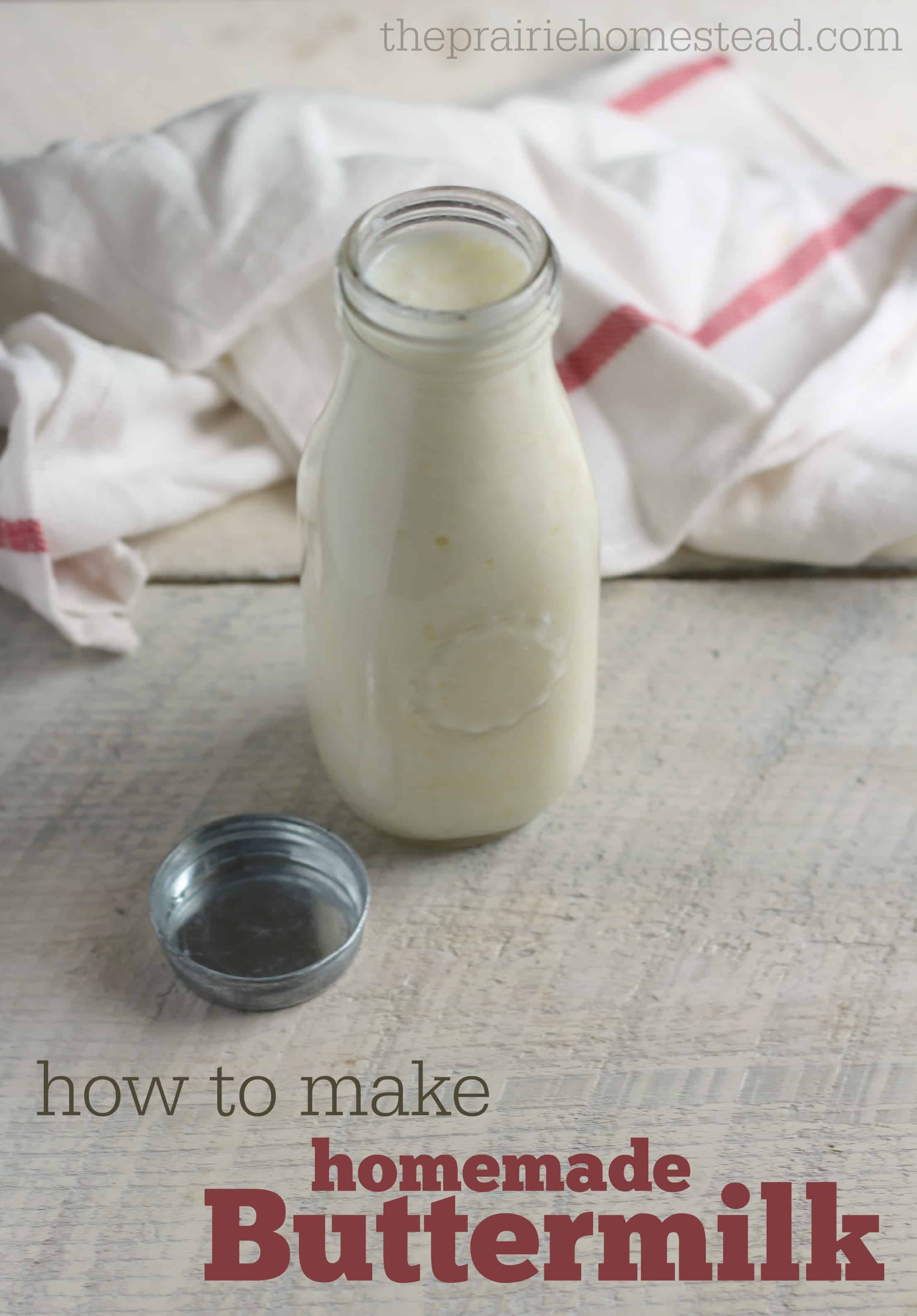
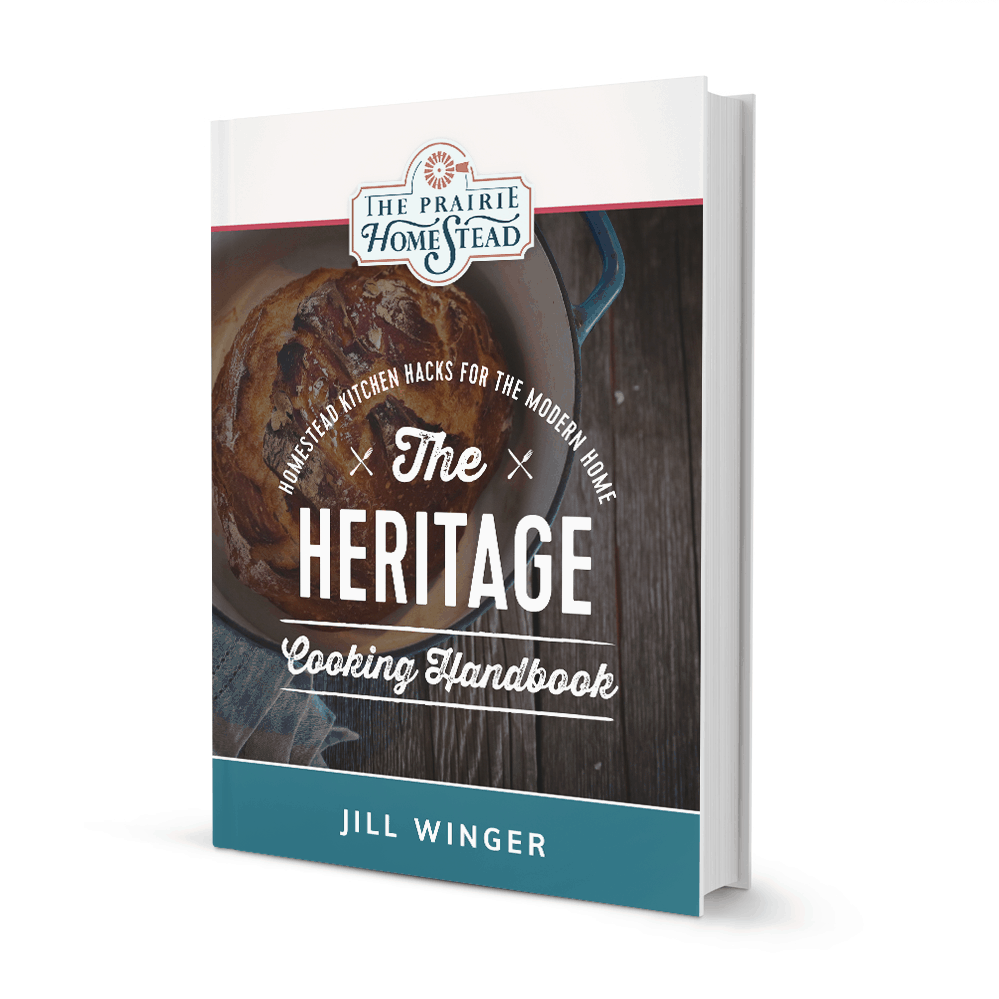
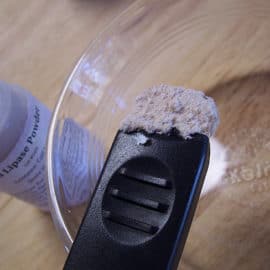
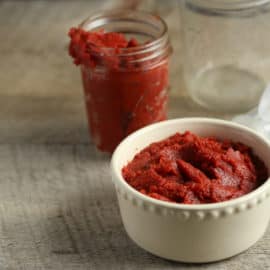
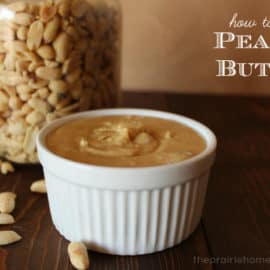
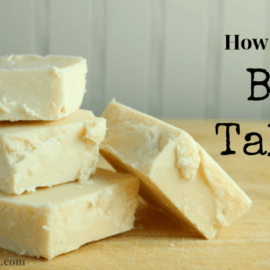
Thank you for the great receipes! Can’t wait to try them!
Have a WONDERFUL MERRY CHRISTMAS!!!
Mare
Hello I have a question . Is there any way to make a cultured buttermilk without any of these starters ? You see I’m a missionary in South America and haven’t been able to find these products here . Thank you for your time !
Im a bit confused. The recipe cor cultured buttermilk and sour cream are exactly the same. Only the headings are different.
Glad I am not the only one who noticed. I am thinking you must put cheesecloth in a sieve and strain the liquid until of sour cream consistency?
For sour cream you can use half and half for the liquid not milk. Or if you want more of a creme fraiche then use heavy whipping cream. Either way the culture part is correct just the milk part is not. It should say half and half or cream. I have made this a few times and it is almost identical to Cultured Buttermilk except the cream or half and half is the base liquid not milk. Good luck
Take raw milk and bring it to a boil for about 1 minute then add homemade starter below. I come yogurt and the cream will rise to the top. You ca churn all the milk and cream together in a stand up mixer, blender or butter churn old-fashioned butter churn or you can just skim off the cream and do the same.
What you get is butter and cultured buttermilk. Strain the buttermilk out.
Homemade starter: place half a lemon into a small bowl of warm milk and let it sit in a warm place for about 16 hours until it sets iand thickens. Use this as a starter to add to gradually larger amounts of milk to turn into yogurt. and then churn as described .
If you don’t have a lemon, Use a chili with the stem intact or use a pod of fresh tamarind to soak in the small bowl of milk
1. I have milk mixed with white vinegar because I wanted to make a buttermilk substitute. Can I use this to culture buttermilk (mixing it with store bought buttermilk)
2. Do not all store bought buttermilk have active culture? The one I bought from Ralph’s doesn’t explicitly say live or active cultured buttermilk, I just thought it was assumed.
3. Will using a smaller ratio or store bought buttermilk to milk inhibit culturing or will it just take longer time?
is this recipe how to make sour cream as that is what it says?
This recipe is for making buttermilk, not sour cream. She simply has the wrong recipe name. All the instructions are correct for making buttermilk. Her sour cream recipe can also be found on this site, but it starts with heavy cream, not milk.
Silly question, but what IS “american cheese”? Is it some form of cheddar? And do you know how to make it?
Haha-good question! I have no clue–it’s some sort of highly processed cheese, and as far as I know, it can’t be made at home. 😉
Even though American cheese is a frankenfood. I grew up on it and like the flavor. I found a wonderful cookbook on Amazon called “The joy of cooking naturally” by Peggy Daeron. On page 19 there is a great American Cheese recipe made from cashews and nutritional yeas and all things healthy. I do not use garlic powder or onion powder. I use the fresh equivalent.
Here is the recipe. In a high powered blender, place 1 cup of hot water. Add 1/3 cup unflavored gelatin and stir on low until dissolved. Pour 1 1/4 cup boiling water over soaked gelatin in blender and whiz. Cool slightly Add 2 cups raw cashews and liquefy. Then add 1/4 cup nutritional yeast flakes. 1 Tbs. unbleached sea salt or Real salt. 2 tsp onion powder (or 1 Tbs fresh onion) 1/4 tsp garlic powder, (or a clove of fresh garlic) 2 tsp of paprika or 1 pimento or 1/2 large sweet pepper. Liquefy until the consistency of a creamy sauce. Makes a quart. Pour into containers that you can lower into hot water to loosen and let cheese out. before you use it. Out in fridge until it sets up before use. This can even be frozen and thawed at room temperature. It is wonderful for cheese lovers who want to avoid hormones and antibiotics. I often soak the cashews after I measure them the night before and rinse several times for a sweeter cashew and to get preservatives natural to the nuts out of them before I use them.
Peggy Dameron ( sorry)
How cool! I never thought of making it yourself–creative!
Hello Jill. Thanks for all the GREAT hints on more natural cooking. I have a uestion about the recipes that you suggest 2 tyoes of cultures, such as buttermilk and sour cream. Which do you prefer, the Mesophelic starter culture or In this case, the buttermilk starter culture? Both ate redily available and i want to choose the best one. Thank you.
https://www.browneyedbaker.com/diy-homemade-velveeta-cheese-recipe/
it could be a good substitute to the “real american cheese”
No American Cheese isn’t a form of cheddar. In fact, it isn’t even cheese. It is made from whey concentrate and some cheese. It is highly processed and contains emulsifiers.
If you set milk at room temp in a jar for a few days it will culture. The 1st time takes longer then you can use that as a starter to speed the process up if desired.
The milk needs to be raw of course, but that eliminates the need to buy a starter. 🙂
That was the question on my mind… Thank you!!
Will this work with store bought milk if you heat it like you heat to make yogurt?
So to make a culture for buttermilk, couldn’t I set out one cup of raw milk for a couple of days, then use that to make my buttermilk?
I would not advise producing buttermilk this way. You could end up with any number of different bacteria that thrive and take over. The way buttermilk ferments safely is because there is already an amount of the GOOD bacteria in the starter(either store bought starter, or saving a small amount of your butter milk). This makes sure that the good bacteria takes hold first.
Not about buttermilk, but wanted to tell you that in the latest (summer) issue of Living the Country Life, there’s a great article about a couple w/ a small farm who grow lavender and make essential oil and other products from it.
I’m not sure if it’s for sale on newsstands; I got a free subscription *somewhere* (I don’t remember, I sign up f/ a lot of freebies) In fact, I get two copies, not sure why. I set one aside to read later, then give the other one away or use it under my cat’s feed & water bowls. I’ve had this one f/ a while and just picked it up earlier to take my mind off the Cowboys game. (but they eventually won!)
Anyway….I just checked and they have a website, but I don’t see the article “Purple Power”. They do have a link f/ a free subscription and if you can’t find the article, then I supposed I could be persuaded to send you my issue, just email me.
http://www.livingthecountrylife.com/
Great little magazine, I enjoy it.
Cool! Thanks for the heads-up!
Hi –
I love this idea however we can’t do cow’s milk in our home. Have you ever tried with goat’s milk? We have access to an organic goat farm and could possibly get raw cream. I’m really interested in making the sour cream. Thanks so much for your help.
It should definitely work with goat’s milk too! 🙂
I’m lactose intolerant and wondered if you can make buttermilk and or sour cream from lactose free products.
Thank you,
Jennifer
I don’t have any experience with lactose-free products, but my gut says that it probably wouldn’t work b/c they are so processed.
I make everything from lactose-free products milk products. The have the enzyme lactase added to break down the lactose and the only difference is the slight sweetness. That is the only processing besides the ultra pasteurization. I have no problems. Lately, however, I’ve been using the lactose filtered milk which has been available in my area for a couple of years. It’s fabulous, doesn’t have the sweetness.
Have you ever researched the difference between raw milk pasteurized milk and ultra pasteurized milk. Pastorized and ultra pastorized have killed off all of the good enzymes and vitamins and other things that are absolutely healthy for you. Raw milk contains the enzyme that actually helps you process lactose. My son had problems and drinking pasta rice milk but he started drinking my cow’s raw milk and he has no problems with it whatsoever. You should check it out. :-).
The fermentation process converts lactose but I do not know it the process is complete enough to make the result lactose free.
I tried making yogurt with lactose-free milk and it definitely did NOT work.!
Thank you for this–and the perfect timing!
Two days ago I discovered that I liked buttermilk. My grandfather used to drink it every morning with breakfast, but every time I tried to drink it (that horrible ultra-pasteurized crap from the store) I thought it was… well… vile.
But my dairy started carrying fresh, cultured buttermilk and I bought some… and it was amazing!
***heads off to the kitchen to see if I can culture my own***
🙂
Oh yes– real buttermilk is heavenly– that tangy smell/taste is delightful!
Can I use fresh goat milk?
Yep! 🙂
Do you heat your raw milk before adding culture? What is your room temperature? Right now mine is in the 60s. Will it still ferment at a lower temp?
Sometimes I use it straight from the cow while it’s still warm, but other times I’ve pulled it straight out of the fridge and it still has worked. It will still ferment at a lower temp, just might take a bit longer.
I made a small amount of buttermilk using 1/4 store bought cultured buttermilk and 3/4 cup 2 percent milk. The end result was a consistency a little thicker than yogurt and ever so slightly gelatinous. It smells great but I’m wondering what happened to my texture? Thanks.
That sounds pretty typical– sometimes mine gets to be a little on the thicker side too.
So, if I used whole milk, I would end up with something like a lower fat sour cream?
Jill,
I just love your posts and recipes. I just ordered my starters and when they come in I’ll be trying your recipes.
Thank you!
yay!
I have buttermilk (left over from making butter with raw cream) Can i culture that verses using milk? I’d love to be able to find more uses for this buttermilk and culturing it sounds like a great idea….in the past a lot has gone to waste ;-(
Hmmm.. it’d be worth a try, although I can’t say I’ve ever tried it before. Another good use for that sort of buttermilk is to use it in baking.
Well I have something that is cultured but its not buttermilk lol! I think i will put it on my dog’s food!
Can you use store bought milk that has expired to ferment buttermilk?
would love to try the sour cream but was wondering if you have tried it with half & half instead of heavy cream which would make it less rich…
Hello,
I tried using the leftover buttermilk from making butter with raw milk to make the cultured buttermilk. It’s been on the counter tightly closed for over 24 hours but hasn’t thickened to coat the jar. Is it bad?
The bacteria needs air to live and grow 🙂
Next time use a towel to cover it.
I always tightly seal mine and leave it on top of the fridge for 24 hours. Mine has always thickened (even thicker than yogurt) and I use Fat Free milk. It sounds like there might be an issue with the culture if it is not thickening.
Before I got the recipes to make my own buttermilk and yogurt, I bought my buttermilk and yogurt at the store. I blended them together and it came out a tasty drink. The blended drink is better tasting than either of them taken separately. And, you can make a small amount at one time instead of a large batch. Just a thought.
I noticed you used a marker to write directly onto your mason jar, instead of a sticky label. Does that come off when you handle it or wash it?
It’s dry erase marker, so it wipes right off. 🙂
Acetone (nail polish remover) will remove sharpie from glass, and plastic, but scrubbing the glass does work also.
Rubbing alcohol also removes Sharpie marker from glass.
I saw the directions on the culture starter website said to heat the milk or cream. Do you have to do that with your method? I’m pretty new to this and would love to try it out .
Thanks!
I would love to know this too. Know matter how many ways I try to look it up, I can’t seem to find an answer anywhere that explains why it might be necessary to pasteurize the mother batch. I only can find recipes that say to do that first and that not doing so may not yield a mother batch good enough to continue further batches. Can you comment on this, Jill?
Is it really necessary to pasteurize the mother batch to have successful future batches? Or is that just the industry being afraid and playing it safe with the consensus? Thanks.
Some types of cultures (yogurt) will work better under warm conditions. So heating the cream to about 110F is the ideal environment for those types of lactic bacteria to grow. This is not a hot enough temp to pasteurize the cream though. Just heat the cream before you add the cultures then let it sit on your counter to ferment as usual.
I’m trying to figure out if I can culture sour cream and buttermilk next to each other or if they will cross-culture.
They should be OK since they use the same type of starter culture.
I have a question. I live in a place where buttermilk is not commercially available, but sour cream is, and I see that the same culture (purchased) was used above to make both. Is it possible to make buttermilk with whole milk and a small ammount of cultured sour cream? Buttermilk is a must for my fried green tomatoes and fried chicken, and I can’t live without it!!! lol
I just finished making my buttermilk, it turned out beautifully. Now I’m making sweet cream butter and I immaculated some cream for cultured butter tomorrow. Thank you, I just love your blog!!
That’s what I like to hear! 😉
Ok I’m working on butter now and I’m having some trouble hoping you can help. Last night I made (tried 😉 sweet cream butter and set out some cultured cream for tonight so we can taste the difference. Well neither one of the darn things will go past the whipped cream stage. I’ve used several methods; shook for 1 1/2 hours in a mason jar, used my blender, and at least 1 1/2 hrs tonight with my kitchen aid mixer. What’s wrong, what can I do to fix it?
Thanks for the great tutorial! I was wondering, is it possible to use whey (leftover from making Greek yogurt) to culture my sour cream? And if so, what would you suggest the ratio of whey to cream would be?
The links to the starter are for yogurt and Kefir. Which if either is OK to use for buttermilk ans sour cream?
This may be a silly question. Just wondering if it’s okay to use cold cultured buttermilk and add to cold milk? Then leave in a slightly warm oven for 24 hours? Thank you!! Looking forward to trying this!!
Yep! I usually just use it cold, and have never had a problem. 🙂
Hi Jill!! It worked!!! I woke up to beautiful buttercream this morning! I’m so excited! Thank you so much for your detailed instructions and your quick response. I can’t wait to make sour cream using your instructions. Love your blog!!
YAY Kathy! Way to go!
Hi Jill! I immediately used the buttermilk that I made as a starter for a new batch. The new batch thickened nicely but looked almost ‘grainy’ and not as smooth as the first batch. Is that normal? I kept all the conditions the same as the first batch.
So cultured buttermilk and sour cream are the same thing?
Please answer this question. It’s been asked twice so far that I have seen?
So it looks like your sour cream recipe and your cultured buttermilk recipe are the same?? What is the difference?
I had the same question… I am wondering if the title was just misnamed…
Ok, great article… but let me get this straight, If-o I have raw milk (I belong to a raw milk co-op) and I purchase 1 packet of direct-set buttermilk starter culture (already purchsased) then I can make buttermilk as you described… THEN, once I have my new batch of buttermilk, can i take one cup of it (before I finish drinking it!) and add it to three cups of raw milk and start a new batch? If this is not correct please let me know…
Yes, that will work!
One tablespoon per cup of milk is all you need to ferment your next batch.
Just a quick note: printable recipe says “sour cream” instead of buttermilk. Trying this today!
Sorry if this is a silly question. I’ve never cultured anything, but would love to get started with it. I was looking at a soaked soda bread recipe and they used cultured buttermilk which brought me here.
So, my question is: are all store bought buttermilk’s cultured? Or do I need to specifically look for one that says “cultured”?
Thanks
Only use whole milk. I use store bought pasteurized milk and have found that if the milk is scalded, the results are better. There may be something store bought that competes with the starter culture resulting in the buttermilk separating, thick on the bottom and semi-clear on the top. This doesn’t happen if milk is scalded.
I let the milk cool to “just warm” and then mix in the starter which is just what is left from a previous batch. Room temperature takes longer but works fine for me. In the winter, I keep it warmer placing the container close to a radiator. Faster, but in my experience, little difference in result.
This is exactly what I was looking for. I am going to make some buttermilk today using the “1 cups buttermilk” method.
A question; I have a cooler kitchen, but I have a Excalibur Dehydrator, what is the ideal temp to culture raw milk buttermilk?
Also, did you know that the actual recipe posted here says Cultured Sour Cream? ?
This is interesting, however ‘buttermilk’ is not cultured milk, it is the liquid that is left over when you make butter (which is made from cream).
This is amazing!!! I’ve got to try this!! Thanks, Jill!
Am I missing something here? It looks to me like the buttermilk recipe and directions are the exact same as the sour cream recipe and directions.
What am I missing?
Some info that people might find useful:
Buttermilk is made with a mesophilic culture (replicates at warm room temperature, 70-77 degrees). Mesophilic cultures can also be used to make sour cream or creme fraiche, just depends how much fat is in your dairy. Exact same method and culture, but using skim milk will get you thin buttermilk, while whipping cream will get you creme fraiche. (by contrast, thermophilic cultures used to make yogurt set at 110-115 degrees) You do not need to heat the milk before you make buttermilk, but it should not be cold. Old-fashioned cultured buttermilk happens when the raw whole milk is allowed to culture BEFORE churning. The result is European-style cultured butter and cultured buttermilk.
I use UHT milk and cream all the time and they set beautifully with both mesophilic and thermophilic cultures. Also, i use a much lower ratio, more like 1-2 tablespoons of buttermilk to 1 cup milk, set on the counter in a warm spot next to the fridge for about 18 hours.
Why is the Buttermilk recipe and the Sour Cream recipe the same?
If using raw milk, how fresh should the milk be? I’m wondering if I have raw milk from a week ago, can I still make buttermilk and have it in the fridge for a couple of weeks at least?
You can totally use older milk for this recipe! Not positive how long it’ll last in the fridge after you make it, but I assume at least another week or so.